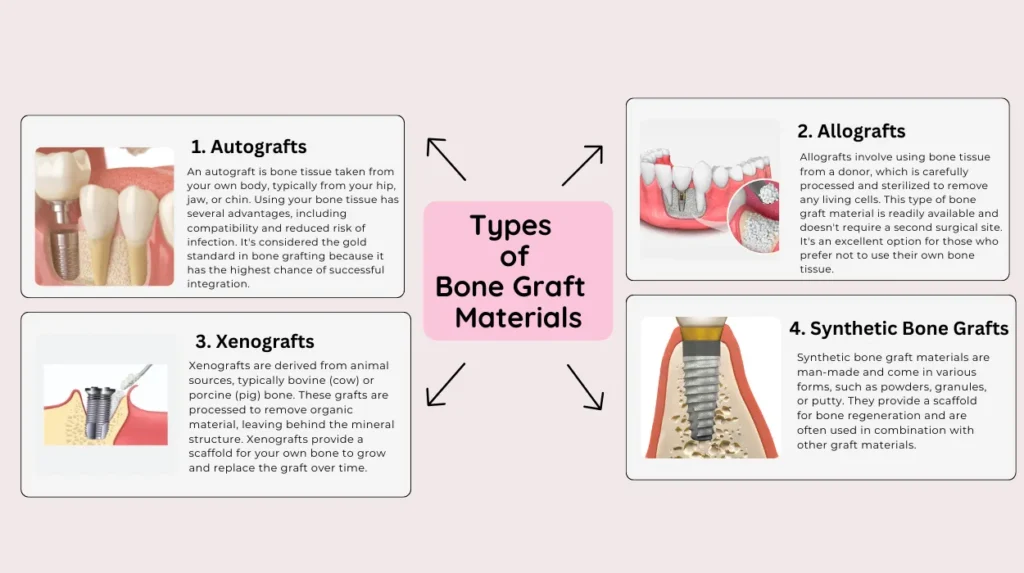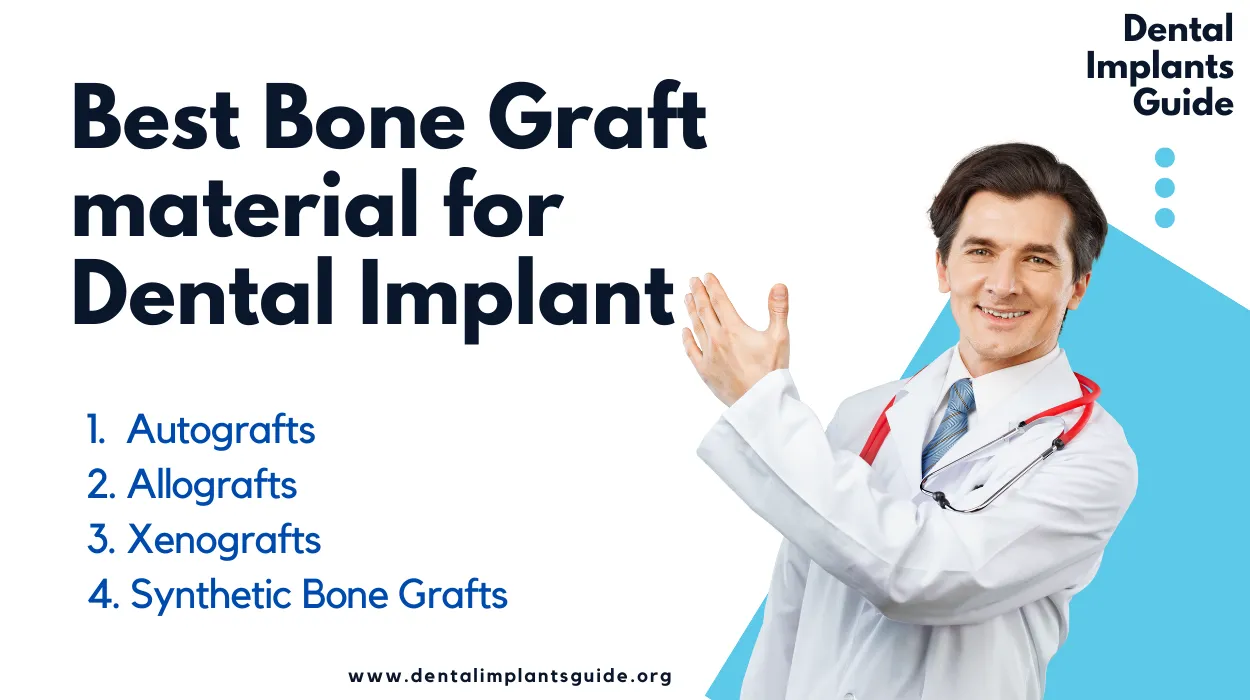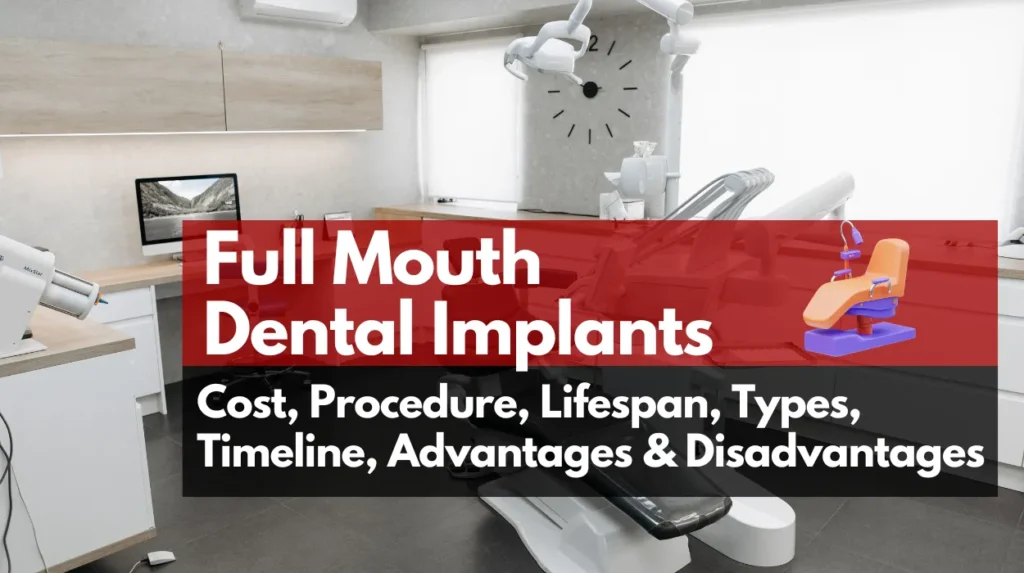Hello readers! Today, we’ll talk about bone grafts for dental implants, which aren’t the most glamorous subject, but are absolutely necessary for a beautiful smile.

I realize this may sound a little technical, but don’t worry, I’m here to help you understand it. Consider the building of a house. Isn’t it true that the structure requires a strong foundation? The same can be said for dental implants.
For a successful and long-lasting dental implant, a solid foundation is required, which is where bone graft materials come into play. This article will will take a look the best bone graft materials for dental implants, explain why they’re important, and provide you with all the information you need.
Why Do You Need a Bone Graft for Dental Implants?
When you lose a tooth, whether due to injury, decay, or other reasons, the bone that once supported that tooth starts to deteriorate. Over time, this can lead to a weaker jawbone, making it challenging to securely anchor a dental implant.
Related Article: Types of Dental Implants with Cost
Types of Bone Graft Materials

There are several types of bone graft materials used in dentistry.
1. Autografts
An autograft is bone tissue taken from your own body, typically from your hip, jaw, or chin. Using your bone tissue has several advantages, including compatibility and reduced risk of infection. It’s considered the gold standard in bone grafting because it has the highest chance of successful integration.
Pros:
- Excellent compatibility.
- Low risk of complications.
Cons:
- Requires an additional surgical site.
- Longer recovery time compared to other options.
2. Allografts
Allografts involve using bone tissue from a donor, which is carefully processed and sterilized to remove any living cells. This type of bone graft material is readily available and doesn’t require a second surgical site. It’s an excellent option for those who prefer not to use their own bone tissue.
Pros:
- No need for a second surgical site.
- Abundant supply.
Cons:
- Slightly lower integration success rate compared to autografts.
3. Xenografts
Xenografts are derived from animal sources, typically bovine (cow) or porcine (pig) bone. These grafts are processed to remove organic material, leaving behind the mineral structure. Xenografts provide a scaffold for your own bone to grow and replace the graft over time.
Pros:
- Easily available.
- No need for a second surgical site.
Cons:
- Slightly lower integration success rate compared to autografts and allografts.
Related Article: 7 Best Alternatives to Dental Implants
4. Synthetic Bone Grafts
Synthetic bone graft materials are man-made and come in various forms, such as powders, granules, or putty. They provide a scaffold for bone regeneration and are often used in combination with other graft materials.
Pros:
- No risk of disease transmission.
- No need for a second surgical site.
- Easily customizable.
Cons:
- Integration success may vary depending on the material used.
Best Bone Graft Materials for Dental Implants
Allografts vs. Xenografts ➥ Allografts, derived from human donors, are widely used and have a proven track record.
Xenografts, sourced from animals, can also be effective but may carry a slightly higher risk of complications due to their non-human origin. Your dentist will help you decide which is best for your situation.
Synthetic vs. Autografts ➥ Synthetic bone graft materials have come a long way in terms of quality and effectiveness. They’re a great choice for those concerned about using donor or autogenous bone.
Autografts are still considered the most reliable option but require an additional surgical site for bone harvesting.
Factors to Consider When Choosing a Bone Graft Material
Selecting the right bone graft material involves considering several factors:
- Biocompatibility ➔ The material should be compatible with your body to prevent adverse reactions or rejection.
- Availability ➔ Depending on your location and the type of material, availability may vary.
- Cost ➔ Different materials come with varying price tags. Consider your budget and insurance coverage.
- Surgical Procedure ➔ The choice of material may influence the complexity of the surgical procedure. Discuss this with your dentist or oral surgeon.
Advantages & Disadvantages of bone grafting
Advantages of Bone Grafting are:
| S. No. | Advantages | Explanation |
|---|---|---|
| 1. | Improved Implant Success | Enhances the success rate of dental implant procedures. |
| 2. | Restores Bone Structure | Rebuilds lost or damaged bone, providing better support. |
| 3. | Increases Aesthetic Appeal | Improves the appearance and function of the smile. |
| 4. | Preserves Facial Structure | Prevents the collapse of facial features due to bone loss. |
| 5. | Diverse Graft Material Options | Offers various materials to suit individual needs. |
| 6. | Minimally Invasive | Most procedures are minimally invasive and well-tolerated. |
| 7. | Prevents Further Bone Loss | Halts or slows down the progression of bone resorption. |
Disadvantages of Bone Grafting are:
| S. No. | Disadvantages | Explanation |
|---|---|---|
| 1. | Surgical Procedure | Requires surgery, which carries inherent risks and recovery time. |
| 2. | Potential Complications | Possibility of infection, graft rejection, or complications. |
| 3. | Costly | Can be expensive, depending on the type of graft material. |
| 4. | Extended Healing Time | May have a longer recovery period compared to non-grafted cases. |
| 5. | Availability of Materials | The availability of specific graft materials may vary regionally. |
| 6. | Not Suitable for Everyone | Some individuals may not be candidates for bone grafting. |
Risks of bone grafting
The risks of bone grafting are:
- Infection
- Bleeding
- Pain
- Swelling
- Damage to nerves or blood vessels
- Rejection of the bone graft
Related Article: Who Is NOT A Good Candidate For Dental Implants?
How to speed up bone graft healing?
Speeding up bone graft healing is something many people want after a dental procedure. While it’s important to remember that healing takes time, there are some things you can do to help it along. Here are some simple tips:
- Rest and Be Gentle ➡ Give your body the rest it needs. Avoid doing things that might put stress on the graft site, like chewing on that side or vigorous rinsing.
- Eat Well ➡ Eating nutritious foods can help your body heal faster. Focus on foods rich in vitamins and minerals, especially calcium and vitamin D, which are good for bone health.
- Don’t Smoke ➡ Smoking can slow down the healing process, so try to avoid it, especially right after the surgery.
- Oral Hygiene ➡ Keep your mouth clean but be gentle around the graft area. Use a soft toothbrush and follow your dentist’s recommendations for rinsing or special care.
- Medications ➡ Take any prescribed medications as directed. These might include pain relievers or antibiotics to prevent infection.
- Avoid Alcohol ➡ Drinking alcohol can interfere with the healing process, so it’s best to avoid it during your recovery.
- Stay Hydrated ➡ Drink plenty of water to keep your body well-hydrated, which is important for healing.
- Follow-Up Appointments ➡ Don’t skip your follow-up appointments with your dentist. They’ll monitor your progress and make any necessary adjustments.
- Stay Positive ➡ A positive mindset can actually help your body heal. Try to stay stress-free and optimistic about the healing process.
What is the safest bone graft material?
The safest and successful bone graft material is usually your own bone,also called an autograft. When you use a piece of your bone, it’s called an autograft. Your body won’t reject it because it’s your own. This makes it the safest choice.
But sometimes, if you don’t have enough of your bone or can’t use it, your dentist might suggest other safe options like processed donor bone (allograft) or animal bone (xenograft), which are also safe because they go through special treatments to make sure they won’t harm you.
Important FAQs
What is a bone graft, and why might I need it for a dental implant?
A bone graft is a procedure where we add extra bone to your jaw if it’s not strong enough for a dental implant. It gives the implant a strong foundation to stay in place.
How do I know which bone graft material is best for me?
Your dentist or oral surgeon will help you decide. They consider factors like your health, budget, and the condition of your jawbone.
What’s the difference between using my own bone and other sources for grafting?
Using your own bone (autograft) is often the best choice because it’s a great match for your body. Other sources like donated bone (allograft) or animal bone (xenograft) can also work well but have some differences.
Are bone grafts safe?
Yes, bone grafts are generally safe. Complications are rare, but like any surgery, there are some risks. Your dentist will discuss these with you.
How long does a bone graft take to heal?
Autografts typically heal within 3-6 months.
What should I expect after a bone graft?
fter a bone graft, you may experience some pain, swelling, and bruising. You may also need to follow a special diet and take antibiotics. Your dentist will give you instructions on how to care for your bone graft after surgery.
Final Thoughts
Choosing the best bone graft material for your dental implant is an important step in ensuring your treatment’s success.
Remember that every patient is different, and what works best for one person may not be the best option for another. You can make an informed decision that aligns with your preferences and circumstances by considering factors such as biocompatibility, availability, cost, and the nature of the surgical procedure.
I hope this guide has helped to clarify the best bone graft material for dental implants. Your smile is worth it, so investigate your options and make your decision.









